There are about 356 known turtle species in the world, but we can’t keep them all as pets. Certain turtle types make good pets, while others don’t. It all depends on their personality and care requirements. Larger turtles are usually harder to care for for the average person.
There are many different types of turtles that are larger and still make good pets. Long-lived and enormous, tortoises can make some of the best companions. Still, there are some aquatic pet turtles that grow to a larger size as well.
Large Pet Turtle Species
1. Red-Eared Sliders
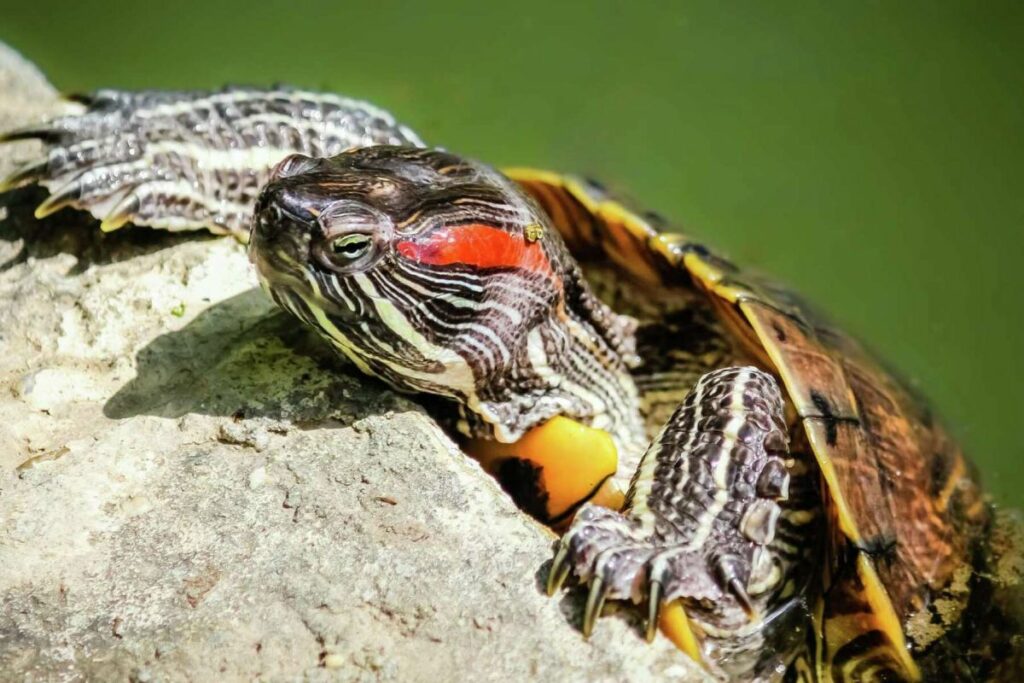
- Scientific Name: Trachemys scripta elegans
- Size: 12-16 in (30.5-40.6 in)
- Lifespan: 20+ years
- Tank Size: 40+ gallons
Red-eared sliders are the most popular pet turtle because of their vibrant colors. They have green and black stripes covering their upper shells. The underside of the shell is yellow, and their heads have a bright red stripe.
2. Florida Softshell Turtles
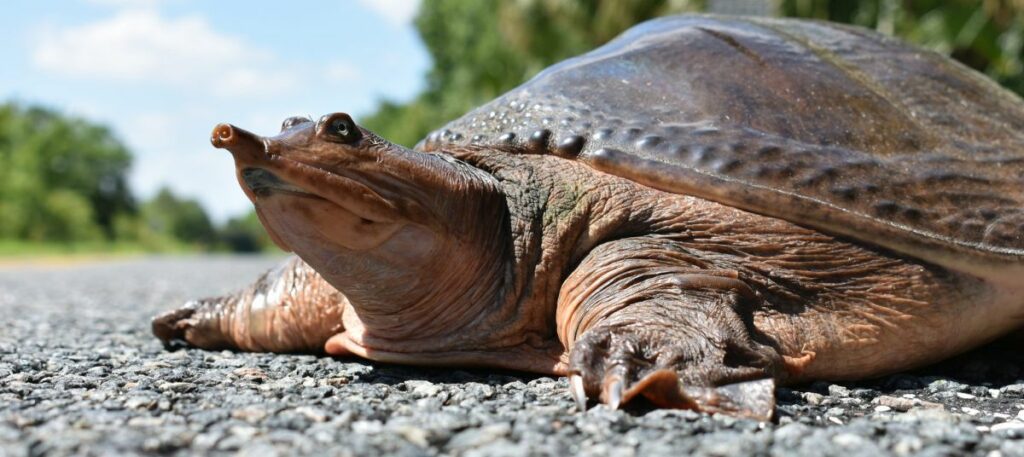
- Scientific Name: Apalone ferox
- Size: 6-24 in (15-61 cm)
- Lifespan: 20+ years
- Tank Size: 75-100 gallons
Florida softshell turtles are unique in that their shells are soft and leathery. The carapace is dark brown or olive in color, and there are bumps on the carapace behind the head. These turtles have unique faces with tube-shaped noses.
3. Yellow-Bellied Sliders
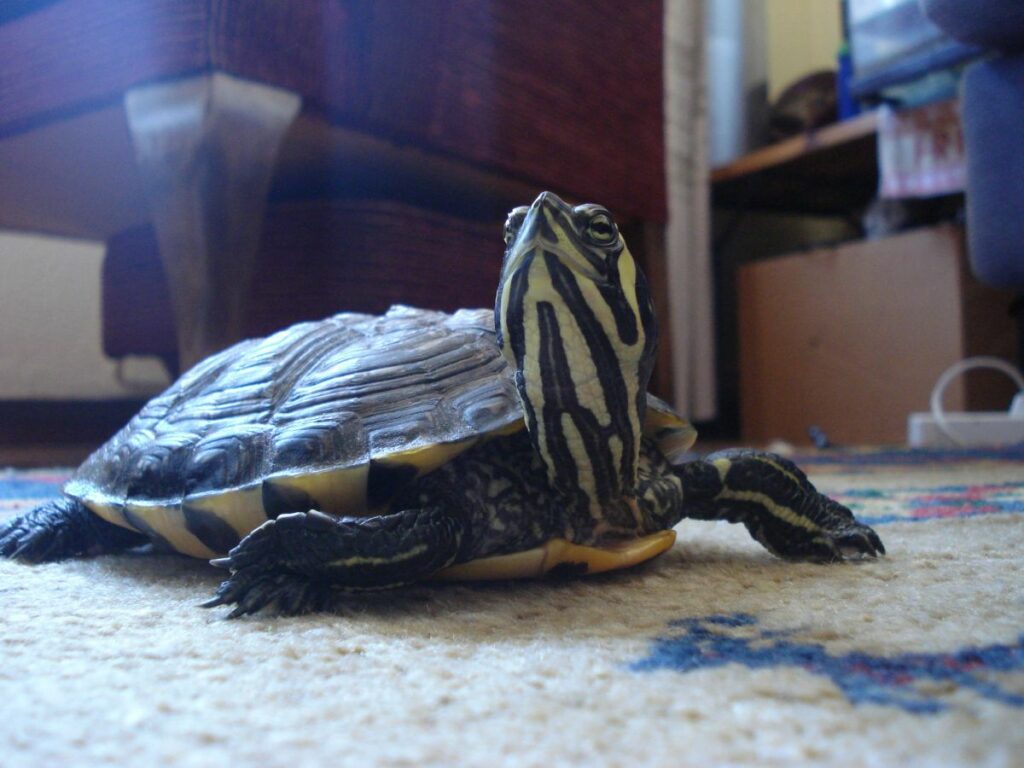
- Scientific Name: Trachemys scripta
- Size: 9-13 in (22.9-33 cm)
- Lifespan: 30-40 years
- Tank Size: 75-100 gallons
Yellow-bellied sliders have a plastron (bottom shell) that is bright yellow. The color of their shell is where they get their name. But, they also have a yellow spot behind each eye that makes them easily recognizable. Juveniles have bright yellow markings that streak across the top of their shells. Older turtles lose some of this coloration and become more subdued.
4. African Sideneck Turtles
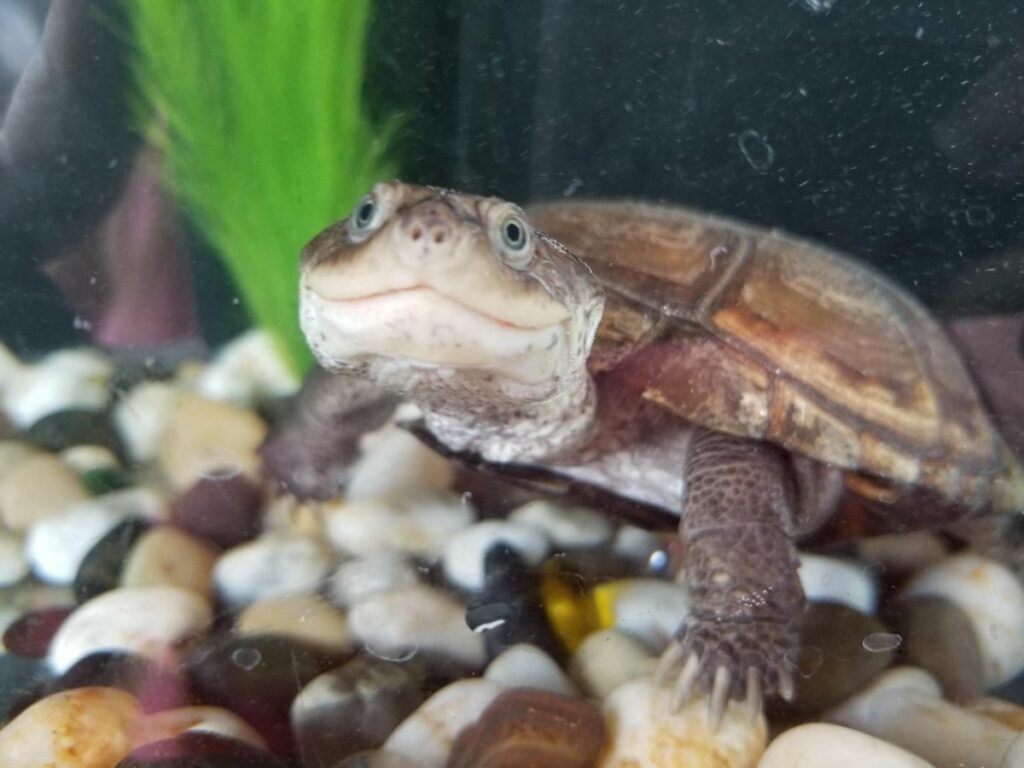
- Scientific Name: Pelomedusa subrufa
- Size: 8-12 in (20.3-30.5)
- Lifespan: 30-50+ years
- Tank Size: 75+ gallons
African sideneck turtles get their name from their super long necks. Unlike most turtles, they cannot retract their necks into their shell for protection. But, they can tuck their head sideways to fit inside the shell.
5. Sulcata Tortoise
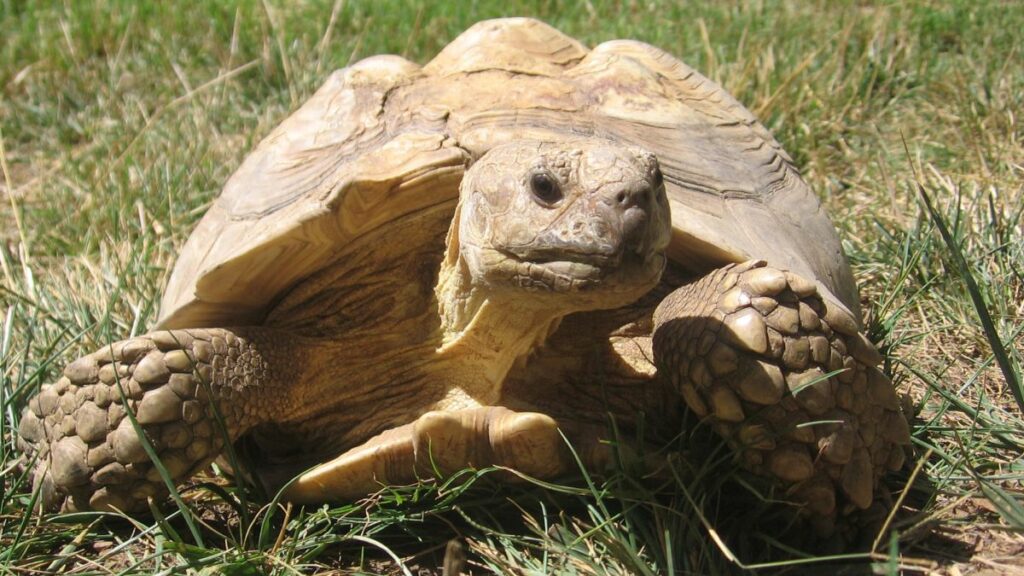
- Scientific Name: centrochelys sulcata
- Size: 24-30 in (61-76 cm) & 70-200 lbs (31.8-90.7 kg)
- Lifespan: 50+ years
- Tank Size: 80 sq. ft (7.4 sq. m)
The sulcata tortoise is also sometimes known as the African spurred tortoise. It is the third largest species of tortoise in the world and is native to central Africa. It is only bested by the Galapagos tortoise and the Aldabra giant tortoise.
If you’re going to keep these tortoises, you’ll need a lot of space. They love to dig and burrow in the dirt to hide from the sun. Most often, their burrows will “only” be about 30 in (76.2 cm) in depth. Still, they are capable of digging tunnels more than 10 ft (3 m) long underground.
6. Mediterranean Spur-Thighed Tortoise
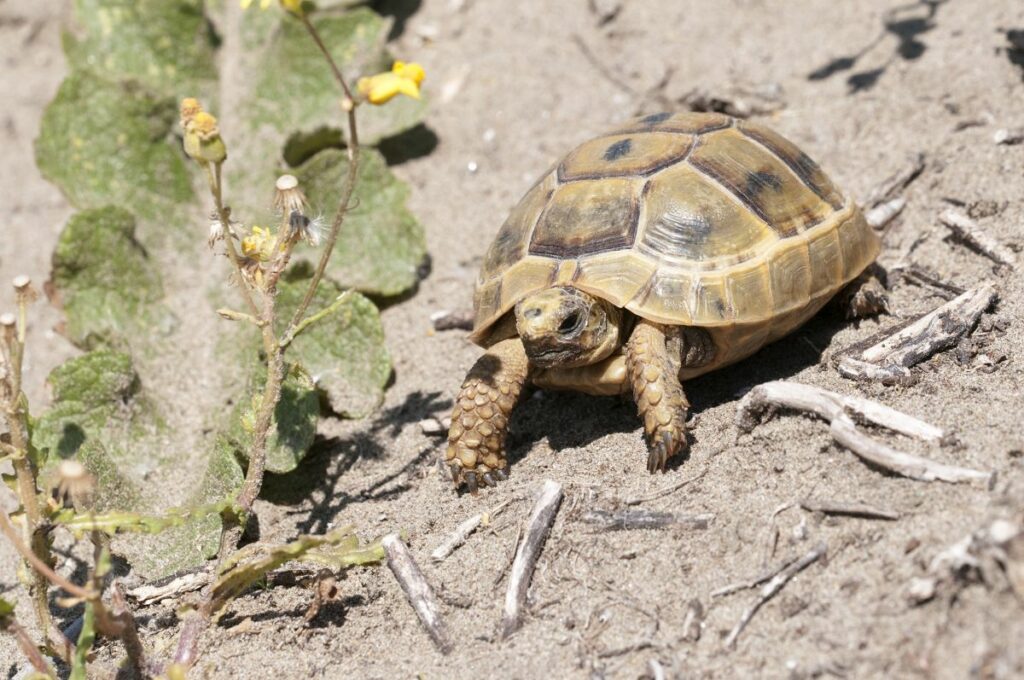
- Scientific Name: Testudo graeca ibera
- Size: 7-11 in (18-27.9 cm)
- Lifespan: 57-127 years
- Tank Size: 3×6 ft (0.9×1.8 m)
The Mediterranean spur-thighed tortoise is also known as the Greek spur-thighed tortoise. They are native to North Africa, southern Europe, and southwest Asia.
These tortoises are one of the smallest tortoises you can keep as a pet. Their upper shell is brownish-yellow to dark brown or nearly black. There are dark blotches and rays across the shell as well.
7. Indian Star Tortoise
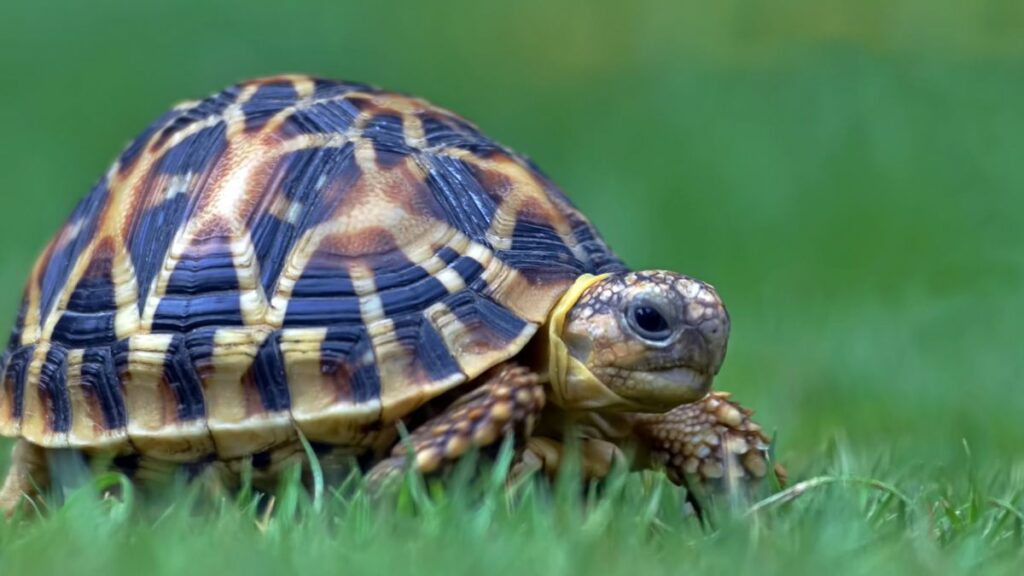
- Scientific Name: Geochelone elegans
- Size: 6-12 in (15-30 cm)
- Lifespan: 25-80 years
- Tank Size: 55+ gallons
Indian star tortoises are native to western India, southeastern Pakistan, and Sri Lanka. They are used to extreme weather such as monsoons and high temperatures.
They prefer to be active in the early morning and late afternoon when the weather is coolest. They will find vegetation to hide in during the rest of the day. When it rains, they become more active, coming out during all hours of the day.
They are a popular species because of their striking coloration. Their carapace may be smooth, or the scutes may jut upward like pyramids. Each scute is yellow at the center, but there are light brown lines shooting from it. The patterning on the scutes resembles a star which is where they get their name.
8. Red-Footed Tortoise
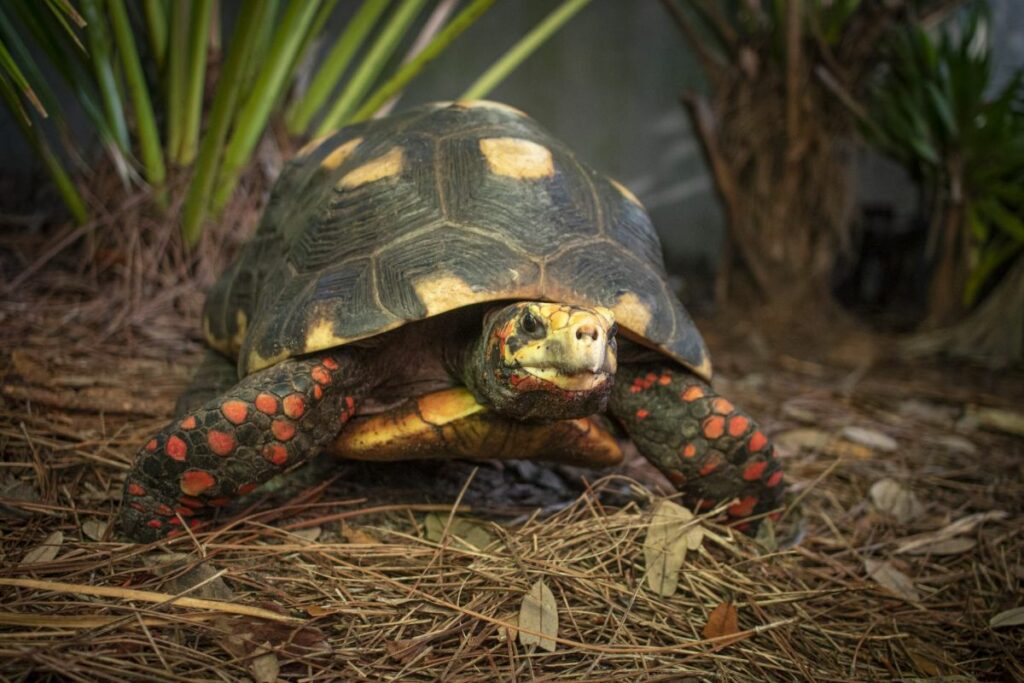
- Scientific Name: Geochelone carbonaria
- Size: 11.25-13.5 in (28.5-34 cm)
- Lifespan: 50+ years
- Tank Size: 4×8 ft (1.2×2.4 m)
Red-footed tortoises are popular among reptile keepers for their bright coloration. They have bright red marks on their head. Yellow, red, and orange markings cover the legs and tail. The rest of their skin is black. The carapace may be black as well or may be gray or brown.
9. Leopard Tortoise
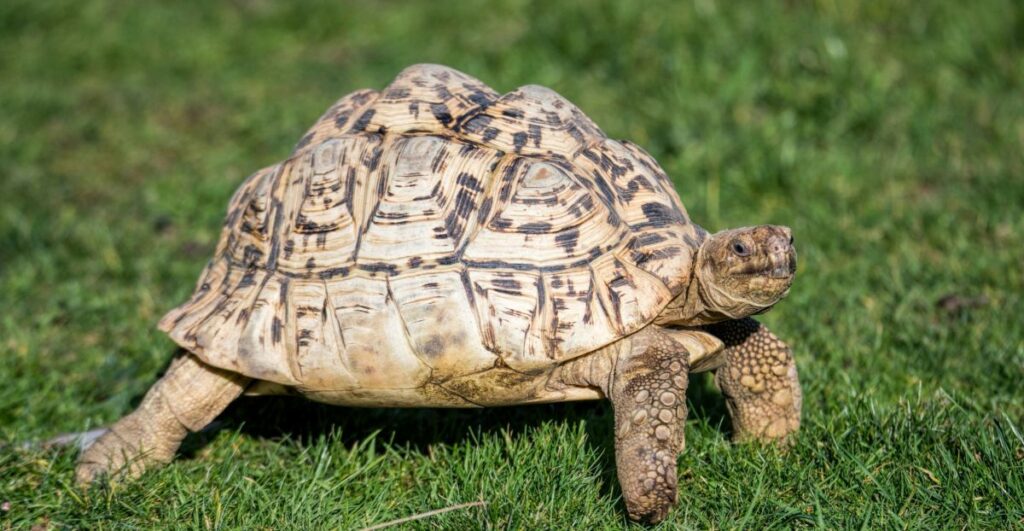
- Scientific Name: stigmochelys pardalis
- Size: 16-18 in (40-50 cm)
- Lifespan: 50+ years
- Tank Size: 10×10 ft (3×3 m)
Leopard tortoises are native to sub-Saharan Africa and South Africa. These tortoises are used to the semi-arid conditions of the desert, so they don’t do well in cold or wet conditions.
They need a lot of space, but their enclosure can be simpler than that of other tortoise species. They can’t climb, and they don’t burrow.
Still, leopard tortoises are high-maintenance and aren’t great for beginners.
These tortoises are distinctive because of their black and yellow carapaces. These colors often form geometric patterns across the top of the shell.
10. Aldabra Tortoise
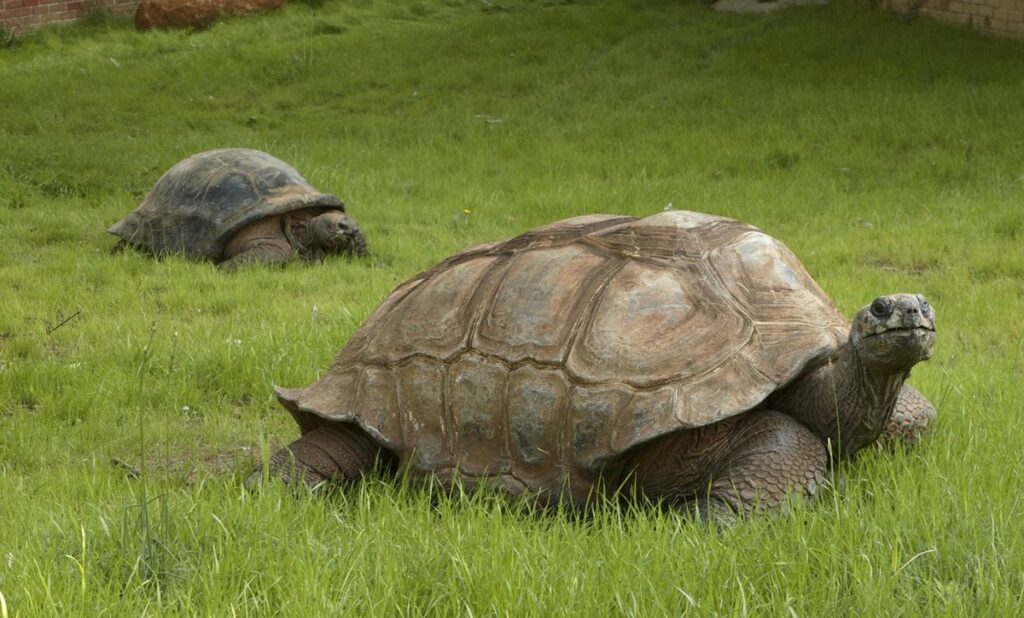
- Scientific Name: Geochelone gigantea
- Size: 3-4 ft (0.9-1.2 m) & up to 550 lbs (249.5 kg)
- Lifespan: 150+ years
- Tank Size: at least 30×30 ft (9.1×9.1 m)
The Aldabra tortoise is one of the largest tortoises in the world. They also live an exceptionally long time. For these reasons, they are not fit for beginners and should only be cared for by expert caretakers.
A small neck plate is visible — a feature not present in most giant tortoises. The carapace is gray to black in color, and they have long necks for gathering food.
Aldabra tortoises can make great pets. They enjoy interacting with their caretakers more than other turtle and tortoise species. The Smithsonian’s National Zoo says:
“Aldabras are one of the more social tortoise species…Aldabra tortoises are easily domesticated and can learn to identify their keepers in a short time.”
Are Turtles & Tortoises The Same Thing?
Many people use the terms “turtle” and “tortoise” interchangeably. But turtles and tortoises are not exactly the same. The word “turtles” is used to describe the aquatic reptiles. “Tortoise” is used to describe the terrestrial reptiles.
The truth is that all tortoises are turtles, but not all turtles are tortoises.
How are you to tell them apart? The Nashville Zoo describes the differences between turtles and tortoises:
Tortoises have more rounded and domed shells where turtles have thinner, more water-dynamic shells. Turtle shells are more streamlined to aid in swimming.
One major key difference is that tortoises spend most of their time on land and turtles are adapted for life spent in water.
Tortoises have club-like forelegs and ‘elephantine’ hind legs. Because tortoise are often larger and heavier, their elephantine hind legs help them move around and carry the extra weight!
Turtles will have more flipper like legs, or webbed feet to make it easier to cruise through the water.
Conclusion
Have you cared for smaller turtles in the past? Are you ready for more of a challenge? You could get one of these larger turtle species. Or, if you prefer land animals over aquatic ones, large tortoises make good pets, too.
Most people will be content with one of these moderately-sized turtles or tortoises. But, if you want a truly unique pet and have the means, you could get the Aldabra or sulcata tortoise. They grow to truly enormous sizes and live long lives, so just be sure to do your research before jumping in.
FAQs
A group of turtles is called a ‘bale’. A bale refers to a large amount of something that has been tied together. The term is often used to describe things like hay, wool, cloth, or paper.
The term has been used for a long time, so we cannot know for sure why the term got applied to turtles. But, it was likely just an easy comparison.
Despite having a term to describe a group of turtles, turtles don’t like living in groups. They are solitary creatures and will often avoid other turtles. Most often, if you find a group of turtles together, it’s because it’s mating season.
Whether a turtle or tortoise is better for you depends on your lifestyle and preferences. Tortoises are often easier to care for since they live solely on land. Turtles often need to be provided with both water and land.
Most tortoises are also herbivorous, while most turtles are omnivorous. So, tortoises need less variety in their diet which can make them easier to care for.
But, tortoises are a much bigger commitment than turtles. Tortoises live significantly longer than turtles. Many tortoise species can even outlive humans, so you’ll need to have a plan in place in case of your passing. Plus, most tortoises grow significantly larger than turtles and need more space.
